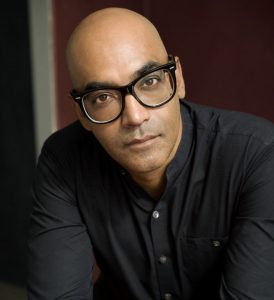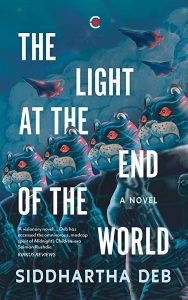Siddhartha Deb’s New Novel Traverses Between Present and Past, the Real and the Unreal
What would it feel like to be trapped inside a painting by Hieronymus Bosch? The 15th century Dutch artist’s work is known for its depiction of hybrid beings and unreal landscapes. Here, the borders between fantasy and reality are blurred. Hidden elements and other symbols point to the possibilities of perdition or salvation, often using irony and contrast. To read Siddhartha Deb’s new novel The Light at the End of the World is to enter just such a zone.
The book can be viewed as a series of dispatches from the bleeding edges of India’s past, present, and future, conveyed through a succession of hallucinatory fever dreams. It seems to be motivated by deep-seated anger at the state of affairs combined with curiosity about how it came to pass. Parts of it are informed by Deb’s reportage and others are shot through with streaks of conspiracy, paranoia, and obsession. This makes The Light at the End of the World almost Pynchonesque in ambition and unlike any other recent work of Indian fiction.

Siddhartha Deb. Photo: siddharthadeb.com
The novel is largely structured as a quadriptych, the first part of which is set in Delhi, a city of “demonetisation and brume”. Here, Bibi, a former journalist, works for a shadowy organisation that advises corporations, think tanks and government agencies. When an influential client uncovers her previous reportage, she burrows into a rabbit hole of theories involving Sandman-like experiments, mysterious thought forms and the machinations of the deep state.
Bibi tries to find out what happened to Sanjit, a former colleague, presumed dead in an accident that took place soon after he published a series of revelatory reports. She starts to feel that she is “both awake and asleep, that some other city is on the verge of revealing itself” in a place where “a gradual dissolving of the boundary between the fantastic and the real is in progress”.
Many strands that recur throughout the book are introduced in this section. These include the Brahmastra, a nationalistic superweapon; the mysterious presence of a mutated Monkey Man; and streams of time in a museum colliding along Borgesian forking paths.
The book now spools backwards, with sections set in 1984, 1947, and 1859. These dates are not arbitrarily chosen. To begin with, a menacing hatchet man follows orders from his political patron in the run-up to the Bhopal gas disaster and travels to the city to take possession of incriminating documents. He finds himself surrounded by “rumours of laboratories and classified projects and occult knowledge”.
Then, on the cusp of Independence, a trainee veterinary surgeon in Calcutta believes that he is acting according to the dictates of a shadowy committee in order to “bathe this damaged, crushed city in the universal harmony song of love”. Along the way, he receives insights from a Savage Freud psychotherapy clinic.
The next section deals with the aftermath of the so-called Indian Mutiny, when a British army officer stumbling through the wilds of Cooch Behar with his company is drawn into the phantasmal world of a mysterious White Mughal. He is soon plunged into a Tarkovskian zone inspired by Arkady and Boris Strugatsky’s Roadside Picnic.

Siddhartha Deb's The Light at the End of the World, Westland 2023
The prose shift registers with the sections, from formal to freewheeling. Throughout, it remains vivid and specific, even when venturing into the oneiric. Sometimes it verges into the broadly satirical, like when a blogger writes of “the Indian conglomerate Ombani with a superbug resistant to every known antibiotic that has been classified as NaMo-03”.
After all this, can Deb stick the landing? Perhaps that’s the conventional, and wrong, question to ask. The last segment returns us to Bibi who, like the reader, has started to feel as though she is “wandering inside a compact, compressed puzzle, one that unfolds to its own inner logic the deeper she goes”.
She sets out to explore a detention centre in the Andaman Islands during an apocalyptic time. Villages, towns and cities are being devastated by surging sea levels, even as the Ganga has become a trickle of brown surrounded by vast sandbanks. Ghosts, fragments, and echoes accompany Bibi on her journey as she ponders over stories of the transcendent and the mundane and the communication between them. While looking for Sanjit, she thinks of what he used to say, “that in a single poem by Agha Shahid Ali there was more truth than in the reams of falsehood published by their newspaper”. The finale of this long, strange trip arrives as the Brahmastra pulses ominously in the background.
In one of Roberto Bolano’s short stories, a character remarks that art captures a secret story. It’s a story “we'll never know, although we're living it from day to day, thinking we’re alive, thinking we've got it all under control and the stuff we overlook doesn't matter”. Through its chimaeras and fantasies, The Light at the End of the World illuminates the secret stories under the surface of our lived reality. It leaves you feeling disoriented and thrilled at the same time.
Sanjay Sipahimalani is a Mumbai-based writer and reviewer.
This article went live on June fourteenth, two thousand twenty three, at twenty-five minutes past four in the afternoon.The Wire is now on WhatsApp. Follow our channel for sharp analysis and opinions on the latest developments.




